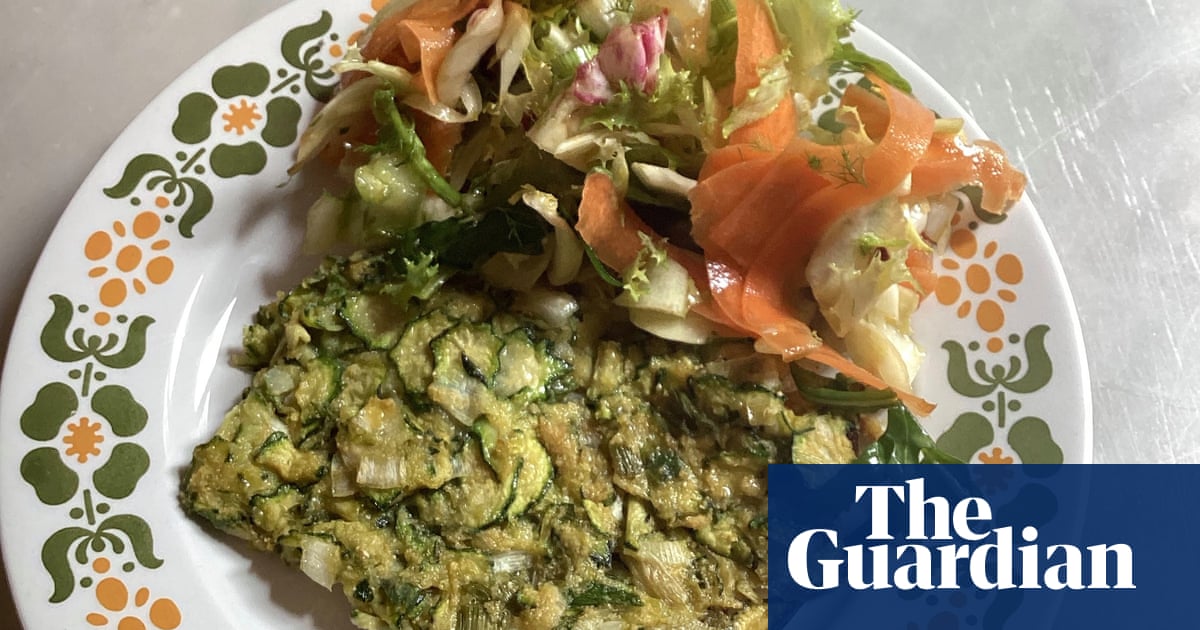Like millions of people all over the world, ideas are often planted in my head by a couple calledAlessandro Vitale and Iasmina P, whose fast-paced videos document recipes they have developed based on the vegetables they grow, with the objective of using absolutely everything. Edited for social media, their videos are designed not just to attract, but to trap attention in a TikTok spell, then communicate a rush of information in a matter of seconds. However, within the well-calculated rush of decisive movements and fishbowl close-ups, Alessandro (otherwise known asSpicy Moustache) is a hugely likable, calm and good teacher.
For months now, his enthusiastic and entertaining approach to a vegetable or process has sent me into the kitchen to grate something and rub it with salt, to turn into a fritter or cake. “Such a vivid thing for us today,” is what Jane Grigson said about the ideas of Giacomo Castelvetro, the 16th-century proponent of vegetables and author of The Fruit, Herbs andVegetablesof Italy (1614), and I think the same can be said about Alessandro.
In fact, Giacomo and Alessandro have a huge amount in common. Born almost four centuries apart, as well as 100 miles apart in Modena and Verona, they both developed a love of vegetables at a young age; moved to England; and became keen gardeners determined to share practical, simple and elegant ways of preparing vegetables. I have long been a fan of Giacomo, even more so now that I have put him in a complementary relationship with Alessandro; the two provide me with multi-dimensional inspiration. I am just sorry they can’t co-present a TV show.
Their double act inspiration this week isscarpaccia, which means old shoe, apparently – a clear image for the thickness of the final dish. It wasAlessandro’s quick-paced videothat taught me about this baked courgette dish, of which there are endless variations, but two broad forms. First, a sweet version, often calledtorta dolce di verdura, a sweet cake of vegetables made from equal quantities of flour and courgettes, along with basil, sugar and yeast. Thenthere is the savoury scarpaccia, typical of the province of Lucca (and in particular the town of Camaiore), for which thinly sliced courgettes and their flowers are baked for about an hour in a batter of egg, flour and cheese.
I have taken inspiration from all the above, plus Castelvetro’s fritters, for this version that tastes like a cross between chickpea flour pancakes (I am thinking here of Italianfarinataor Indianbesan ka chilla) and vegetable and chickpea flour fritters, such as pakoras.
Looking again to Giacomo and Alessandro for inspiration, a grated cabbage, beetroot and apple salad with feta would be good here, as would a green salad dressed according to Castelvetro’s sacred law of salads: plenty of salt, generous amounts of oil and a little vinegar.
1kg courgettes, with flowers, if possible1 bunchspring onions2 heapedtbspchickpea(gram) flour1 heapedtbspgrated parmesanSalt and freshly ground black pepperExtra-virgin olive oil
You need a nonstick, roughly 36cm x 20cm baking tray, with a lip. Using a mandoline, the cheese slicer of a box grater or a sharp knife, slice the courgettes and onions (both white and green parts) into thin rounds. If you have courgette flowers, roughly chop them.
Put the sliced vegetables (but not the flowers) in a colander or sieve sitting on a plate and sprinkle over two teaspoons of salt. Use your hands to scrunch the salt into the vegetables, then leave them to sit for two hours. The vegetables will release liquid as they sit, but it pays to press down, so as much liquid as possible is released on to the plate (reserve the liquid for now).
Put the sliced vegetables and flowers in a bowl and add the chickpea flour, parmesan, some salt and a few grinds of pepper, and toss everything together. It may be that there is still enough moisture in the vegetables that the flour coats them with a sticky, batter-like texture; if not, add a little of the reserved liquid and toss again. Tip the mixture into the tray and level with your hand – it should be about 1cm deep. Zigzag the top with olive oil and bake at 200C (180C fan)/390F/gas 6 for 20 minutes.
